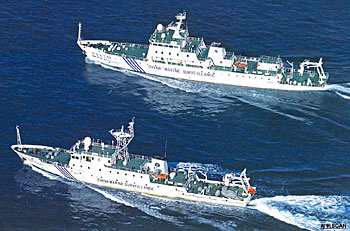INDIAN ARMED FORCES CHIEFS ON
OUR RELENTLESS AND FOCUSED PUBLISHING EFFORTS

SP Guide Publications puts forth a well compiled articulation of issues, pursuits and accomplishments of the Indian Army, over the years

I am confident that SP Guide Publications would continue to inform, inspire and influence.

My compliments to SP Guide Publications for informative and credible reportage on contemporary aerospace issues over the past six decades.
Neihbourhood
China’s Enhanced Ocean Surveillance

There is growing concern that as China’s military prowess increases, an improved and more effective ability to monitor all activity in the neighbouring seas might severely curtail the freedom that other nations enjoy of using sea routes for innocent passage
China’s use of marine capability is upending long-standing notions about how maritime power is wielded in peacetime. The China Marine Surveillance (CMS), the national ocean monitoring agency, has recently announced plans to buy 36 inspection ships over the next five years and hire more than 1,000 people in the next few months, raising the strength of the employees to more than 10,000. In a statement issued on May 2, 2011, the Director of the CMS outlined the agency’s perspective plans with respect to expansion of capability. China’s present complement of 300 marine surveillance ships, he said, are insufficient to carry out regular sea patrols and a need is being felt to strengthen law enforcement in Chinese-related waters to safeguard the country’s marine rights. he also hinted that new and advanced equipment might be installed in the inspection fleet to improve the capacity.
Towards a Greater Marine Surveillance Capability
The CMS, created in 1998, is a paramilitary maritime law enforcement agency of the State oceanic Administration of the People’s republic of China. officially, the force is responsible for enforcing law and order within China’s territorial waters, exclusive economic zones (EEZ) and shore, protect maritime environment, natural resources, navigation aids and other facilities, and to carry out maritime surveys. More practically, the CMS is a major force multiplier for the PlAN that virtually subcontracts the arduous surveillance activity to the marine agency that also doubles as a search and rescue force in an emergency.
The addition to equipment, platforms and personnel at the CMS, though significant, is just one of the many proactive measures Chinese authorities have taken towards augmenting maritime surveillance in the seas surrounding China. on April 22, 2011, a large surveillance ship called the China Maritime Surveillance 26, was added to the agency’s fleet in a bid to enhance protection of the country’s maritime interests. The patrol ship—the second such platform to be added in the last eight months—has a displacement of more than 1,000 tonnes, and has joined the North Sea fleet of the China Maritime Surveillance force in Qingdao in Shandong Province. Its surveillance capability is pronounced, but significantly the depiction of the ship’s role in official reports goes well beyond “preventing violations of China’s maritime interests and protection of the marine environment” to also include “investigation of submarine resources and sea floor facilities”.
The State Council, China’s Cabinet, had in 1999, announced plans to increase the CMS’ fleet of 1,000 tonne-plus sea patrol ships. The CMS 26 is but a small part of a 1.6-billion yuan ($246 million) plan to increase the force strength by 13 more ships and five patrol helicopters. out of these, 10 ships and five helicopters have already been procured and the remaining three ships are expected to be put into use by June 2011. CMS-75, a ship reported to be the fleet’s fastest with a maximum sailing range of 5,000 nautical miles, joined the fleet in october 2010 and is now deployed in the South China Sea.
Marine Observation Satellites
Meanwhile, China has been ramping up its maritime observation capability through ocean satellites. Maritime surveillance, prioritised at the national level under China’s 863 State high-Technology Development Plan, is receiving significant funding. over the past decade, China has launched two haiyang (ocean) maritime observation satellites and has also recently expanded its fleet of Yaogan satellites, which China describes as merely engaging in civilian earth observation missions. These have however been identified by experts as dual role, military reconnaissance satellites and are said to carry a mix of optical as well as radar-based sensors. According to Andrew erickson, Associate Professor, China Maritime Studies Institute at the US Naval War College, one of these satellites, Yaogan-7, is supposed to have optical sensors and Yaogan 8 appears to be equipped with synthetic aperture radars (SAR) that offers wide coverage at sufficient resolution. Yaogan satellites 9A, 9B, 9C are, reportedly, the most capable satellites as they fly in a formation, which suggests that they function as some form of naval ocean surveillance system (NOSS).





